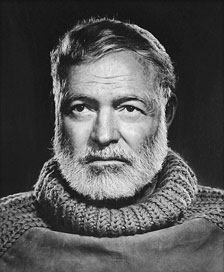Much of the plot was written in correspondence with Frederic J. Agate. Agate, Hemingway’s friend, had a collection of letters to his wife from his time in Italy, which were later used as inspiration.
Michael Reynolds, however, writes that Hemingway was not involved in the battles described. Because his previous novel, The Sun Also Rises, had been written as a roman à clef, readers assumed A Farewell to Arms to be autobiographical.
A Farewell to Arms was begun during his time at Willis M. Spear’s guest ranch in Wyoming’s Bighorns. Some pieces of the novel were written in Piggott, Arkansas, at the home of his then-wife Pauline Pfeiffer, and in Mission Hills, Kansas, while she was awaiting delivery of their baby. Pauline underwent a caesarean section as Hemingway was writing the scene about Catherine Barkley’s childbirth.
Hemingway struggled with the ending. By his count, he wrote 39 versions of it “before [he] was satisfied”. However, a 2012 edition of the book included no fewer than 47 alternate endings.
The novel was first serialized in Scribner’s Magazine in the May 1929 to October 1929 issues. The book was published in September 1929 with a first edition print-run of approximately 31,000 copies. The success of A Farewell to Arms made Hemingway financially independent.
The Hemingway Library Edition was released in July 2012, with a dust jacket facsimile of the first edition. The newly published edition presents an appendix with the many alternate endings Hemingway wrote for the novel in addition to pieces from early draft manuscripts.
The John F. Kennedy Presidential Library and Museum Hemingway collection has two handwritten pages with possible titles for the book. Most of the titles come from The Oxford Book of English Verse. One of the possible titles Hemingway considered was In Another Country and Besides. This comes from The Jew of Malta by Christopher Marlowe. The poem Portrait of a Lady by T. S. Eliot also starts off by quoting this Marlowe work: “Thou hast committed / Fornication: but that was in another country, / And besides, the wench is dead.” Hemingway’s library included both works by Eliot and Marlowe.
Censorship
There are at least two copies of the first edition into which Hemingway had re-inserted the censored text by hand to provide a corrected text. One of these copies was presented to Maurice Coindreau, the other to James Joyce. Hemingway’s corrected text has not been incorporated into modern published editions of the novel, but there are some audiobook versions that are uncensored.
A Farewell to Arms was banned in the Irish Free State.
Also, the novel could not be published in Italy until 1948 because the Fascist regime considered it detrimental to the honor of the Armed Forces, both in its description of the Battle of Caporetto and because of a certain anti-militarism implied in the work. More than one biographer has suggested that, at the base of the censorship of the Fascist regime in the novel, there had also been a personal antipathy between the writer and Benito Mussolini. Hemingway had interviewed him in 1923, shortly after he had seized power, and in Hemingway’s article in the Toronto Star he poured scorn on Mussolini, calling him “the biggest bluff in Europe”. But, apart from the official reactions, it is known that Mussolini did not like the article at all: Hemingway described Mussolini as trying to impress the media by pretending to be deeply absorbed in reading, while in reality he was holding a French–English dictionary upside down. The Italian translation had in fact already been prepared illegally in 1943 by Fernanda Pivano, leading to her arrest in Turin.
Critical reception
A Farewell to Arms was met with favorable criticism and is considered one of Hemingway’s best literary works.
Gore Vidal wrote of the text: “… a work of ambition, in which can be seen the beginning of the careful, artful, immaculate idiocy of tone that since has marked … Hemingway’s prose”. The last line of the 1929 New York Times review reads: “It is a moving and beautiful book.”
Baker remarks on the theme of A Farewell to Arms: “After ten years of meditation and digestive of his experience, Hemingway lays before his readers a work which is far from a mere war experience, nor a story of love and death during the war.”
However, since publication, A Farewell to Arms has also been the target of various controversy. Upon its flimsy publication—due to the medium of its release—through Scribner’s Magazine, it was banned from Boston newsstands due to accusations of a pornographic nature, despite Hemingway’s deliberate exclusion of graphic descriptions of sex, using omission as a literary device.
In other media
The novel was first adapted for the stage by Laurence Stallings in 1930, then as a film in 1932, with a 1957 remake. A three-part television miniseries was made in 1966. In December 2023, a new film adaptation was announced, with Michael Winterbottom to direct and Tom Blyth to star.
The 1996 film In Love and War, directed by Richard Attenborough and starring Chris O’Donnell and Sandra Bullock, depicts Hemingway’s life in Italy as an ambulance driver in the events prior to his writing of A Farewell to Arms.
A radio broadcast adaption was produced in 1937 as part of the Lux Radio Theater series, starring Clark Gable and Josephine Hutchinson. In 2011, BBC Radio 4 produced a 10-episode adaptation for their 15 Minute Drama series.
